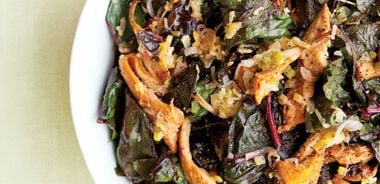Chard and Mushroom Mead Sauté

1 Tbsp (15 mL) extra-virgin olive oil
2 leeks, cleaned well, cut in half, and chopped
3 shallots, thinly sliced
2 garlic cloves, minced
1/2 lb (225 g) wild mushrooms such as chanterelles, sliced
1/4 cup (60 mL) dry mead
1 bunch chard, stems removed, chopped
Pinch of salt
Heat oil in skillet. Add leeks, shallots, and garlic; cook, stirring occasionally, for about 5 minutes or until vegetables have softened. Add mushrooms and mead and cook for another 5 minutes. Add chard and salt; cook just until chard is wilted.
Serves 4.
Each serving contains:
96 calories; 3 g protein; 4 g total fat (1 g sat. fat, 0 g trans fat); 12 g carbohydrates; 2 g fibre; 96 mg sodium
source: "The Mead Renaissance", alive #351, January 2012




